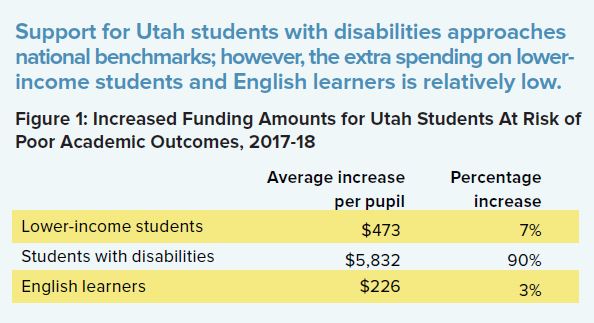The Governor’s Education Excellence Commission, led by Governor Herbert, voted to focus its efforts in 2018 on “providing support to students at risk of academic failure.” It suggests a strategy for the Utah Legislature to “consider additional state funding … based on student risk factors.” Demographic and economic factors can affect the cost of promoting academic success. Lower household income, disability status and lower English fluency can all be rough indicators of the need for a different type and higher level of support.
Utah Foundation’s report on this issue specifically addresses the additional funding provided for students at risk of having poor educational outcomes. The idea is that instead of providing all students with the same type of education, it is important to provide “at-risk” students with the unique supports they may need to succeed in school. These supports might include additional time after school, summer classes, smaller group settings or one-on-one attention.
Key Findings of the Report
- Utah receives the lowest per-pupil federal funding in the nation. These federal funds are primarily directed toward students at risk of poor academic outcomes.
- In Utah, combined federal and state funding for lower-income students is about 7% higher than per-pupil spending for other students. This is far below suggested levels from the federal government and various independent studies.
- The federal government expects states to carry most of the financial burden of supporting English learners, but it is not clear that Utah is even matching the federal spending for English learners.
- Compared with other states, Utah comes up short in English learner educational spending, providing only about a 3% increase in combined federal and state funding.
- The federal government estimates that students with disabilities require twice the spending of other students. Utah’s combined federal and state funding suggests that Utah nearly reaches that mark, even though the federal government’s commitment to funding special education comes up short.
- In light of Utah’s low overall per-pupil spending, the challenge of reaching adequate funding for targeted groups may be more acute. Increases in targeted funding for at-risk populations should be viewed in this context.
Read the report here.


